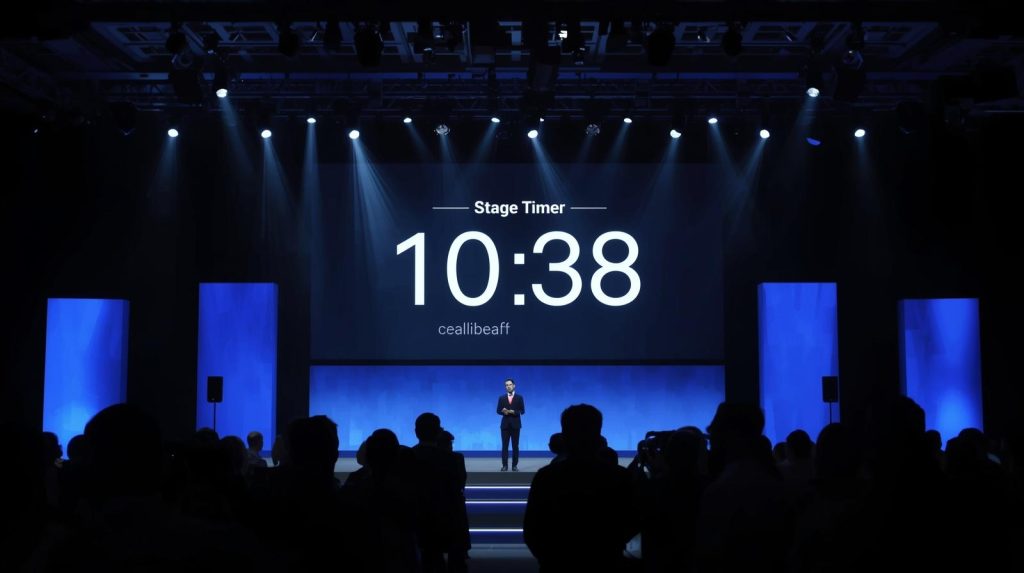The Role of Visual Stage Timer in Modern Event Presentations

The Role of Visual Stage Timer in Modern Event Presentations
In the fast paced world of events, conferences, webinars, and professional meetings, managing time effectively is critical. A minor delay in one session can cause a ripple effect, impacting other presentations and frustrating attendees. This is where a stage timer comes into play. By providing real-time visual cues, stage timers help speakers and moderators stay on schedule. Using a countdown timer for presenters or a countdown timer for presentation ensures that sessions begin and end on time, improving the overall flow and professionalism of the event. Whether it’s a webinar, live conference, or hybrid session, a countdown timer for stage is essential for smooth execution and audience satisfaction.
Understanding the Visual Stage Timer
A visual stage timer is a digital timer displayed prominently on stage or through a shared screen in virtual events. Unlike traditional wall clocks or manual timers, a stagetimer provides precise, easy-to-see countdowns. It allows speakers to monitor their time without disrupting their flow. With a webinar timer, moderators can coordinate multiple speakers efficiently, and event organizers can avoid overlaps or extended sessions. Modern stage timers often offer remote control capabilities, color-coded alerts, and integration with presentation software, making them indispensable in professional event setups.
Why Time Management is Critical in Events
Poor time management in events can lead to numerous issues: sessions running late, speakers missing their slots, or attendees losing focus. An event timer helps mitigate these problems. For instance, keynote sessions, breakout discussions, and panel presentations all have strict durations. Using a timer for presenters allows speakers to pace themselves, while organizers can keep the event on track. For webinars, a webinar timer ensures each segment, such as live Q&A, stays within its allotted time, enhancing attendee experience.
Features of an Effective Visual Stage Timer
An effective stage timer includes several essential features:
- Remote-controlled countdown timer: Event staff can adjust time without interrupting speakers.
- High visibility: Large display screens or LED boards ensure the timer is noticeable to presenters.
- Platform integration: Syncs with virtual meeting software and physical stage setups.
- Custom alerts: Warning signals and color-coded cues for ending sessions.
- Flexibility: Suitable for hybrid, online, or in-person events.
These features make the timer not just a clock, but a vital tool for keeping presentations seamless and professional.
Using Stage Timers for Different Event Formats
Conferences:
With multiple speakers and breakout rooms, a countdown timer for stage helps moderators coordinate transitions and maintain punctuality.
Webinars:
A countdown timer for webinar keeps live sessions structured, ensuring Q&A, polls, and discussions fit within the scheduled slot.
Workshops & Training Sessions:
Hands-on workshops benefit from a timer for presentation to maintain engagement and avoid rushing participants through exercises.
Panel Discussions:
Multiple panelists can track their speaking time using a countdown timer for presenters, making the discussion smooth and fair.
Setting Up a Visual Stage Timer
To set up a stage timer effectively:
- Choose the right timer: Digital displays, software, or hybrid solutions.
- Integrate with your platform: Connect with webinar software, projectors, or presentation slides.
- Configure session timings: Assign duration and warning alerts for each speaker.
- Test before the event: Run a rehearsal to check visibility and accuracy.
- Sync for hybrid events: Ensure both in-person and virtual attendees experience consistent timing.
Best Practices for Event Timer Management
- Position timers where speakers can see without distraction.
- Pre-configure durations for each session.
- Use stage timer alerts subtly to avoid disrupting presentations.
- Encourage coordination between moderators and speakers.
- Update timers in real-time if session lengths change unexpectedly.
Following these practices ensures events run smoothly, whether in-person, virtual, or hybrid.
Common Challenges and Solutions
Even with stage timers, challenges can arise:
- Timer not visible: Ensure placement and screen size are adequate.
- Overrunning sessions: Use a countdown timer for stage to adjust remaining time quickly.
- Multiple sessions: Centralized timers allow organizers to track different rooms or virtual channels simultaneously.
- Speaker distraction: Make timers noticeable but non-intrusive.
Addressing these challenges keeps events professional and efficient.
Benefits of Using Visual Stage Timers
- Time efficiency: Keeps sessions on schedule, saving hours across multi-session events.
- Reduced stress: Speakers and moderators know exactly how much time remains.
- Professional presentation: Smooth transitions and punctual sessions enhance audience satisfaction.
- Hybrid event readiness: Works seamlessly for in-person and online participants.
- Better audience experience: No delays or confusion, keeping engagement high.
Conclusion
A stage timer or countdown timer for presenters is more than a tool; it’s an essential component of professional event management. By using a countdown timer for presentation, event organizers, webinar hosts, and conference managers can ensure each session runs smoothly and on time. Integrating a webinar timer or countdown timer for stage in your event planning reduces stress, avoids overlaps, and improves overall attendee satisfaction. Modern events demand precise timing, and visual timers are the most reliable way to achieve it.
Whether you’re managing workshops, webinars, or large-scale conferences, adopting visual stage timers can transform your event operations, making every presentation punctual, organized, and engaging.